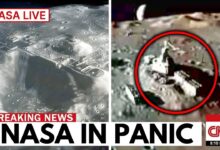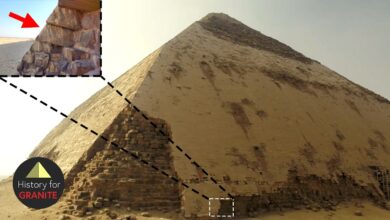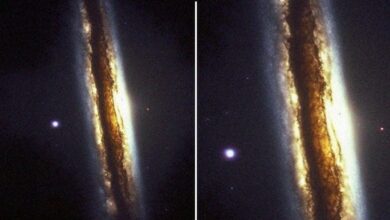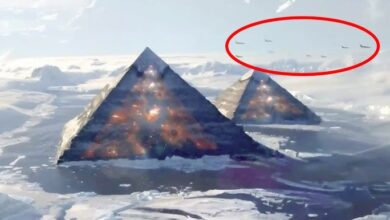The US SHUT DOWN The James Webb Telescope After It Revealed What NASA Hides On Mercury

NASA has shut down its James Webb Space Telescope after it revealed the secrets the agency had hidden about Mercury. Despite its proximity to the Sun, the planet is anything but ordinary. It has unexpected treasures like diamonds on its fiery surface and an unusually large core that have upset previous scientific predictions. Many questions have been raised about these secrets and what makes Mercury different from other planets in the Solar System.
Mercury may look small, but recent explorations have revealed that its surface is littered with diamonds. In addition, the planet’s core is larger and more unusual than originally thought, forcing scientists to reassess its structure. The Mariner 10 mission captured the first close-up images of the planet, revealing a surface riddled with strange craters and grooves, along with a stronger-than-expected magnetic field.
The MESSENGER mission then continued to explore Mercury in greater depth, discovering large amounts of calcium and magnesium on the dark side of the planet, raising questions about its natural processes. In addition, Mercury’s magnetic field was stronger at the north pole – a big surprise. This led to the conclusion that Mercury had a different structure and evolution than other planets.
The planet faces extreme environmental conditions: daytime temperatures reach 806°F (430°C), while nighttime temperatures plummet to -292°F (-180°C). Studies have also shown past volcanic activity and found ice in sun-dappled craters at the poles, suggesting the possibility of water ice despite Mercury’s close proximity to the Sun.
The BepiColombo mission, launched in 2018, will arrive at Mercury in 2025 to collect more detailed data. Surprisingly, a day on Mercury is longer than its year: it takes 176 Earth days to rotate once on its axis, while it takes just 88 days to orbit the Sun. This creates strange phenomena where the Sun appears to stop, go backwards, and then move forwards.
Mercury also has a unique orbital resonance: for every two orbits around the Sun, it rotates three times on its axis. This contributes to extreme temperature swings between the sides facing the Sun and those in shadow.
Mercury’s surface also contains volatile elements such as sulfur and potassium, raising further questions about their origin. One theory is that these may have arrived on comets or asteroids after the planet formed. Mercury’s core makes up 85% of its volume, compared to just 15% on Earth, leading scientists to believe that Mercury was once larger but was hit by a powerful impact that stripped away much of its outer layers.
Mercury’s magnetic field is also not centered, but is offset by about 20% of its radius, possibly related to the differential heat escape from the core. New discoveries continue to reveal mysteries, making Mercury a fascinating subject of study and raising new questions about how planets form and evolve.
The “hollows” on Mercury are shallow depressions created when volatile materials on the surface evaporate. This finding suggests that Mercury has more volatile materials than originally thought. In 2020, data from the MESSENGER spacecraft revealed that a large magma lake once existed beneath the planet’s surface. This magma lake shaped both the surface and deeper layers of Mercury, and contributed to the creation of large smooth plains, particularly in an area known as the “Northern Volcanic Plains.” These plains were formed by massive lava flows early in Mercury’s history.
In 2022, new research discovered nitrogen hidden beneath the surface, possibly the remnants of a thick atmosphere that once existed. This atmosphere may have been pushed underground by high temperatures and intense radiation from the Sun. The discovery raises the question of whether Mercury once had a different climate, perhaps even supporting the chemical processes necessary for life.
Mercury also has water ice in dark craters at its poles, where sunlight does not reach and temperatures are always very low. Analysis suggests that some of this ice may have been delivered by comets or asteroids in the last few tens of millions of years. In addition, the dark areas in the polar craters also contain organic matter, providing an opportunity to study the distribution of organic molecules in the Solar System.
Geologically, Mercury does not have plate tectonics like Earth, but faults on its surface indicate that the planet contracted as it cooled. These faults form when crustal plates are pushed against each other, forming ridges of faults several kilometers high. Evidence from a 2019 study suggests that Mercury is still geologically active, with small valleys (“grabens”) formed by crustal stretching near major faults.
Mercury’s magnetic field is also different from Earth’s. While Earth’s magnetic field is generated by the flow of molten iron in its outer core, Mercury’s magnetic field may be caused by the flow of liquid metal around the solid core. This suggests that complex and dynamic processes still exist inside the tiny planet.
The hypothesis that there is underground water beneath Mercury’s crust has further intrigued scientists. If there are underground pockets of water, they could be remnants from a time when Mercury had a more temperate climate or kept in a liquid state by heat from the planet’s interior. The discovery is similar to the oceans hidden beneath the ice on moons like Europa and Enceladus, and could change our understanding of where life might exist in the Solar System.
Studying Mercury not only helps shed light on the planet’s history, but also plays a key role in understanding how rocky planets, including Earth, form and evolve. New discoveries from Mercury open up new research opportunities and could change our current understanding of the Solar System. Future missions with advanced technology will continue to explore Mercury’s surface and interior, providing more insights into this mysterious planet.








